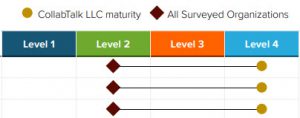Microsoft’s Employee Experience (XP) Maturity Assessment Tool
In case you missed the news this week, Microsoft has released a new Employee Experience (EX) Maturity Assessment Tool in partnership with the Josh Bersin Company, a consultancy focused on corporate learning, recruiting, talent and HR strategy. In a blog post by Seth Patton, General Manager of Microsoft 365, Microsoft made available the free assessment tool, as well a new EX-related case study, and pointed people once again to recently shared internal research and a recent study by the Josh Bersin Company on the hybrid workplace and impacts of the pandemic. There is a nice summary of the assessment tool’s release over on CMSWire.
Yes, that is a lot of links for an introduction paragraph.
Why am I sharing this information? Whether or not your company has started investigating the new Microsoft Viva offerings, this is a category that Microsoft is continuing to invest in, and one you should pay attention to. Earlier in my career when I was involved in the world of project and portfolio management technology, I discovered very quickly that managers and executives were less interested in gantt charts and task dependencies, and more interested in learning from the patterns of behaviors at a project and at a portfolio-level. They were interested in understanding why one project, or one team working on multiple projects, was more successful than others — and whether they could track, measure, and take action on a project that began to diverge from those successful patterns.
That is essentially what Viva and the category of EX solutions is attempting to create for organizations: a way to capture transactional data about the way people collaborate (adoption and engagement metrics), identify patterns in behavior, and interpret what that data means — and then take action on that data.
 I caught wind of some of Microsoft’s investments in an EX maturity model tool and/or methodology a few months back, and have been waiting for news to break. I’ll be honest — while the research is interesting and the assessment tool itself provides some value, it’s not what I had hoped. I can’t share screenshots of the assessment or my own results, as the images/content are copyrighted, but I can provide some feedback:
I caught wind of some of Microsoft’s investments in an EX maturity model tool and/or methodology a few months back, and have been waiting for news to break. I’ll be honest — while the research is interesting and the assessment tool itself provides some value, it’s not what I had hoped. I can’t share screenshots of the assessment or my own results, as the images/content are copyrighted, but I can provide some feedback:
- My biggest issue is that the results of the assessment tool are completely subjective based on your answers to a (very long) survey. People show unconscious bias when completing surveys about themselves or their companies, usually painting themselves in a more positive light.
- While the “pitch” of the assessment is that you have an opportunity to compare your company to “950 organizations spanning 16 industries” from around the world and see your EX strengths and opportunities for improvement, with guidance on how to improve them, none of this is based on empirical evidence. In other words, it’s interesting and can help inform you of areas on which to focus, but what you need is actual data from your organizational collaboration patterns — and tools and guidance on how to read them.
- The problem with maturity models is that we automatically want to see ourselves within the top level, no matter what it is, when our true target (and realistic goal) might be lower down the scale. Microsoft’s assessment tool focuses on four levels (from lowest to highest): Transactional Efficiency, Supportive Environment, Purpose-Driven Business, and Equitable Growth, but the output does not provide a lot of (or any) background on these levels. Maybe that info is deeper within the associated research, but I would think that the output of an assessment like this would take a little more time to outline and justify the methodology used.
- What is needed, in my humble opinion, is a data-driven assessment tool (as opposed to survey-driven) combined with this maturity model AS WELL AS the Microsoft 365 Maturity Model. Yes, I know that EX is all about the human factors of the workplace, while the M365 maturity model focuses on the technology workloads. These are mutually exclusive concepts. However, I believe that alignment of both models can improve the quality and accuracy for both outputs.
In summary, yes, you should go take the assessment for your organization, answering the 100+ questions to your best ability (again, very subjective), and review the results. I’m sure you’ll find some of the suggestions informative and useful. However, go into it with the right expectations, and let me know what you think.




